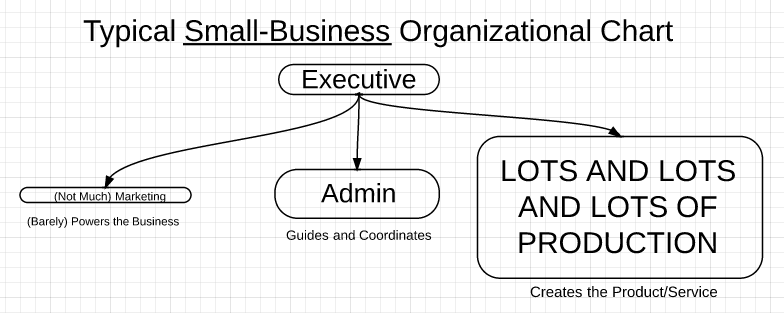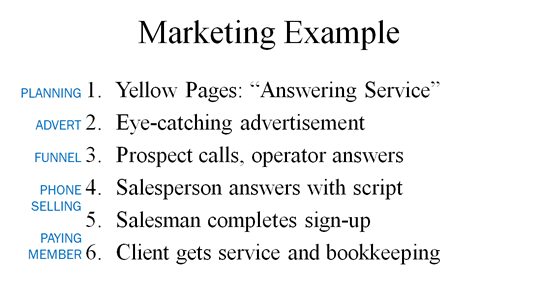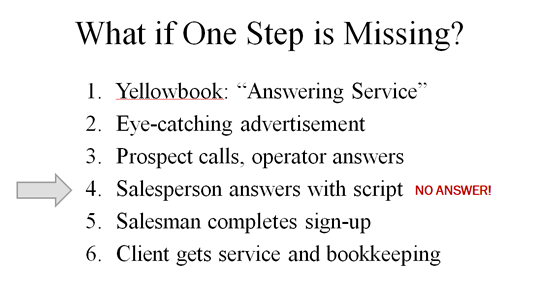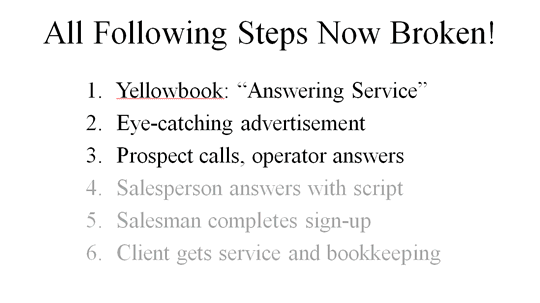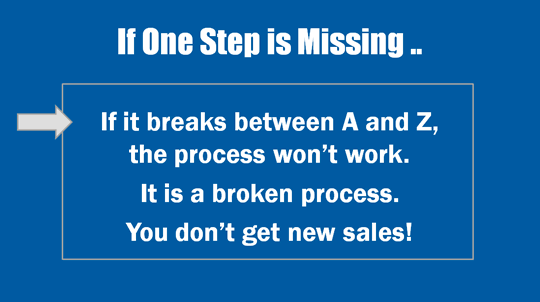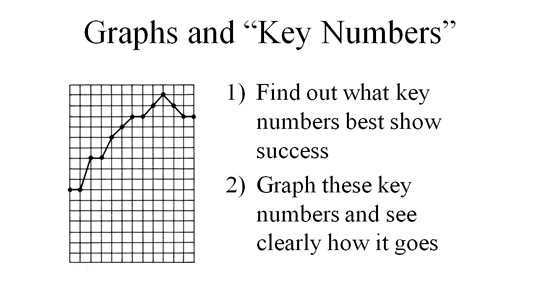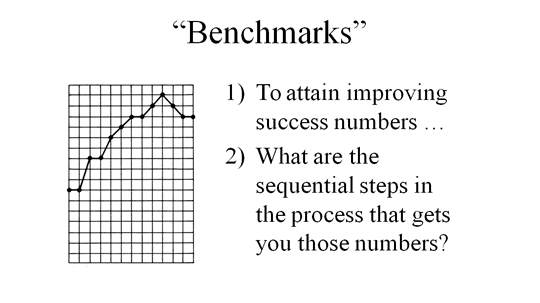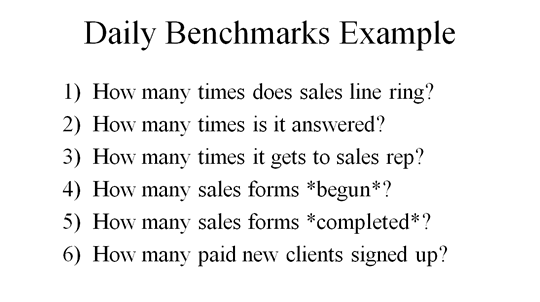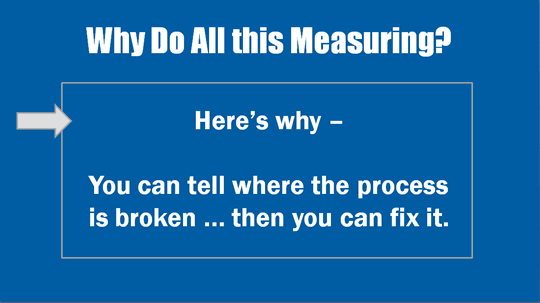A Concise Owner’s Guide to Reliably Walking New People In the Door Every Single Week, without Pain or Struggle or Erratic Results
— by Arthur Cronos
After many decades, running a number of my own businesses and assisting with marketing solutions for more than a hundred other businesses, some truths have become clear and simple. Many people, including myself once upon a time, are unaware of these ideas and so they do not implement these ideas.
The concept that growing a business accrues to a few simple principles, and that you can simply manage the growth of your business by the numbers, is simply not commonly known. Perhaps that is why the Small Business Administration research shows that 50% of all new businesses fail within two years, and 80% of them fail within five years.
The SBA could not find a single common factor to account for the failures; the SBA could merely report that the owner committed some fatal error. But the errors owners commit are all over the place.
I don’t have solutions for all of this … but I do know how you can apply three simple principles and your business will grow. If you succeed with this, then the struggle will diminish and vanish. Profits will rise. Life is good.
Interested?
If you’re not, you’re either a huge success already and don’t need to read this … or else you should give up the foolish notion of being self-employed and go get a job, and help some other entrepreneur build his business.
Illustrating the Principles of Business Growth in Five Steps
- The common problem of struggling businesses
- Marketing consists of three parts. Which one is usually failing?
- If you measure, you can manage. If you can manage, it can improve.
- One example of an outreach program: the Facebook Messenger system
- Resources — Are you a good candidate? Getting the fast Business-Growth Analysis.
In order to keep this quick-start guide clear, simple, and concise, I’m going to cover the ground quickly. If you need or want additional help then contact me and perhaps I can help. If enough people request additional help, I’ll consider creating a more expanded guide on this subject.
The Common Problem of Struggling Businesses
This is actually rather simple, but business-owners seem never to think much about it. Let’s take a look at a normal Organizational Chart (“Org Chart”) which shows the four branches of pretty much any business —
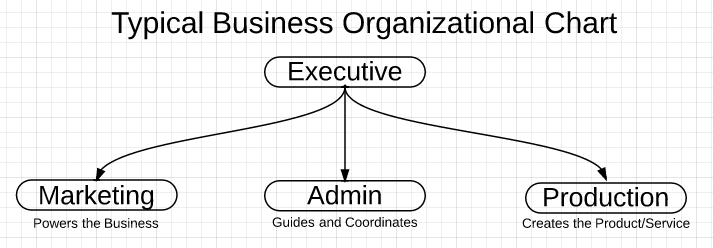
It’s fairly self-explanatory. General Motors will have an Org Chart that looks like this, and so will the Espresso Cart sitting in a parking lot. It might be one person, or it might be 300,000 people, but somebody is in charge (Executive), and somebody is taking care of the three functions that are needed by any business:
- Someone must be handling the production of whatever the business provides;
- Somebody must be taking care of Marketing and selling whatever the business provides; and
- Somebody must be taking care of the administrative stuff that’s neither marketing nor production. (Stuff like sweeping the floor, taking out the trash, doing the books, buying and refilling supplies, paying bills, finding and hiring people, etc.)
The business and these four parts, operate much like an automobile —
The Executive is whoever is driving. The Engine and Controls and Drive Train correspond roughly with Marketing, Admin, and Production. We needn’t dwell much on this, but do notice one thing — The Engine (Marketing) is where the Power comes from.
Now all that is well and good. And in large businesses, if you look at their numbers, one thing leaps out: Their Production division requires time and money and resources, as you’d suspect. But their Marketing division also requires what may be a surprising amount of time and money and resources. (The Admin division should be as lean and simple as possible, because it neither powers the enterprise nor does it deliver the goods.)
And here’s the rub: When Mike the mechanic started thinking about leaving the Ford dealership and starting his own business repairing cars in his own shop, he pictures himself repairing cars. That’s his original idea; that’s the picture in his mind. And so when he goes into business, his Org Chart probably looks like this —
The vast majority of small businesses launch with a LOT of thought and investment and focus on their core technology. And the average business owner is usually *brilliant* at his core technology. Mechanics really, really know how to fix cars. Restaurant owners really, really know how to make tasty dishes to serve to customers. Yoga studio owners really, really know how to teach yoga to students. Hair Salon owners really, really know how to cut and color hair. After all, they usually come in with these developed skills, and this is exactly what they spend most of their time thinking about, when they picture their soon-to-be new business.
But how many such businesses survive and prosper?
Precious few.
You see, almost nobody thinks, “Maybe I’ll start my own business. I’ve never really done any marketing before, but I’ll spend each day doing marketing and I’ll become expert at copywriting and all the changing online methods. Oh, yeah, and I’ll repair cars for people.” The entrepreneur doesn’t think like that. Why would he? He thinks about his core technology and pictures himself doing just that. Is it any wonder that his marketing systems are under-developed?
FACT: SALES AND CASH-FLOW ARE THE LIFEBLOOD OF A BUSINESS
And of course sales and cash-flow come from the Marketing division.
Now here’s a quick-and-dirty proof, using information you already know.
Think for a minute about some large and successful businesses you know. Do they possess well-developed Marketing systems? Then answer is: Yes, they do. And as a result of these well-developed Marketing systems, they have a constant influx of new prospects, new people to talk to, new prospects to sell to, new customers to bring cash-flow into the business.
Now picture smaller and continually-struggling businesses that you have known. How many possess well-developed Marketing systems? How many have a constant influx of new prospects, new people to talk to, new prospects to sell to, new customers walking in the door with cash to give to the business?
You will notice an amazingly simple truth —
A. Successful and growing businesses have functional Marketing Systems that work well; and
B. Struggling businesses do NOT have functional Marketing Systems that work well.
So if a business owner wants to stop running a struggling business, and would like to become a successful and growing business, then what must that business owner do?
Answer: to become a successful and growing business, it is NEEDFUL to create and operate an ongoing and effective Marketing System. If a business owner succeeds in this, his business can grow. If he does not do this, his business will struggle forever. So ask yourself: Is your business struggling?
TALENTED PEOPLE? WELL, THAT’S NICE, BUT SYSTEMS ARE BETTER
If you had a choice, and you could either have an incredibly-good salesman, or you could have a pretty-good system in your business, which would you rather have?
Although it is tempting to think about having an incredibly-good salesman, the fact is that someday he will fall in love with Betsy and move to Cleveland to start a family, and then what you got? You got nothing. The problem must be solved all over again, from scratch. With this approach, you’re basically solving (or failing to solve) the same problem over and over again.
Whereas, if you have a pretty-good system, when your salesman Danny left, you’d simply hire Chuck, show him the system and let him work, and your sales would continue.
The salesman was not a true asset that you own. But a system is actually an asset that you own. And it’s reliable.
 It’s the same in each of the three departments. For example, in production perhaps you have a polishing system that makes sure the widgets you manufacture are always shiny before they get boxed and shipped. In admin, perhaps you have a thermostat on the wall; this is a system that keeps the heat operating just enough and not too much. And in marketing, perhaps you have found some sort of advertisement, or some kind of direct mail sent out every single month, some kind of outreach system that regularly finds adequate numbers of people to talk to, to persuade, and sell to.
It’s the same in each of the three departments. For example, in production perhaps you have a polishing system that makes sure the widgets you manufacture are always shiny before they get boxed and shipped. In admin, perhaps you have a thermostat on the wall; this is a system that keeps the heat operating just enough and not too much. And in marketing, perhaps you have found some sort of advertisement, or some kind of direct mail sent out every single month, some kind of outreach system that regularly finds adequate numbers of people to talk to, to persuade, and sell to.
Systems rule. If it’s not a system, that part of your business can fly out of control at any time.
Most business owners tend to gravitate to the use of systems in Production and Admin, but in Marketing? Not so much.
A weak marketing system is like a volkswagon engine trying to motor a fully-loaded Greyhound bus down the road. It might work sometimes, but the first steep hill you encounter, it’s breakdown time.
SUMMARY — The common problem of struggling businesses is that they do not have an adequate and effective Marketing System in place.
Marketing Consists of Three Parts … but Which One is Usually Failing?
There are three activities required in the Marketing division of your company —
- An effective Outreach system
- A reliable and ongoing follow-up system
- Selling and closing
1) AN EFFECTIVE OUTREACH SYSTEM
For almost any business, if you do not actively reach out, the world will NOT come knocking on your door. Even if you have invented a better mousetrap, if you do not spend energy, time, money, or resources in a systematic outreach program, the actual people in the world will never know about your better mousetrap and they will be unable to beat a path to your door.
I’ve heard business owners delude themselves in several ways.
THE “WE DON’T ADVERTISE” BOGUS BELIEF — Sometimes they claim that “We don’t advertise.” I often find this really funny. For example, a guy has a restaurant or a gym, and he’s paying a FORTUNE in rent for this space every month. But he’s not thinking clearly.
The restaurant guy is thinking he’s paying all that money for a dining room and a kitchen. But really, he’s paying all that money for a dining room, a kitchen, and a LOCATION where his SIGN is visible to passing traffic. The more passing traffic, the better. The more attractive the sign and the building, the better. He is spending a huge amount of money every month for the physical advertising provided by his signage and attractive building.
Somehow it never occurs to him to think, “Why don’t we get a really cheap and ugly warehouse space down in the funky part of town?” You know it would be far cheaper, but he’d be losing the good advertising of his good signage, appearance, and quality location. So when he says he doesn’t advertise … well, this fellow just hasn’t thought it through.
THE “WORD OF MOUTH” BOGUS BELIEF — Another thing they sometimes say is, “We get our business from word-of-mouth.” It sounds good, doesn’t it. But here is how word-of-mouth actually works —
- Generally by means of paid advertising, signage and location, or just over the years the business slowly grows, and when it hits a certain number of customers, then word-of-mouth becomes ONE of the sources that brings new business. For most businesses, word-of-mouth is a happy accident that happens now and then. But when you hit a certain number, assuming you deliver good value, it starts to become a predictable and repeatable source.
. - For example, a number of years ago, I started up several answering service and voicemail companies in and around the San Francisco Bay Area. And every time my paid advertising would start to bring some customers, and my client base would grow. I used to graph this every week. And every single time, when we had finally gained about 300 customers, then I would start to notice 1-2 word-of-mouth sales every week. By the time we’d hit a thousand clients, we got a half-dozen word-of-mouth inquiries every week.
. - Nobody *starts* from nothing with word-of-mouth advertising. It is a function of how many customers you already have, and if you are small and struggling, you can stay small and struggling forever if you are trying to rely on word-of-mouth to bring you enough sales for growth.
. - General rule, your location and signage should bring some customers, but unless you want to struggle with slow growth and pinched cashflow for a long, long time, you find some effective and reliable outreach SYSTEM to bring you the new people to fuel the growth you want. And then you take the “free” word of mouth as an additional payoff from your investment in a good outreach system.
HOW MUCH OUTREACH IS NEEDED? WELL, HOW MANY NEW PROSPECTS DO YOU NEED EACH WEEK?
To figure out how much outreach is needed, you work backwards. You want slightly more new prospects coming in than you need. Because if you have “too few” then you’re struggling, and growth stops. And if you have “just enough” then in the normal happenstance of life on this planet, one day something will break or go wrong, and then you’ll again have “too few.”
The number of prospects you want showing up each week is “slightly more than you need,” or “slightly more than you can handle.”
This gives you a wonderful feeling of security, a chipper attitude, and if you get a real jerk of a client you will feel comfortable firing that client. You want to have that freedom; you will love how it feels. And you’ll be kinder to your significant other, to your children, and to the dog and cat.
How much growth do you want?
Again you use the same principle. You want your growth (in dollars or in number of clients) to be a slightly-rising graph. When you have that, then bumps in the road won’t break your system. You’ll weather the ups and downs, and on average you grow.
If you want your business to grow, you will need an effective, reliable, repeating outreach system. Something that will reach and attract an adequate number of prospects so that your follow-up and your selling actions give you a slightly rising graph.
2) A RELIABLE AND ONGOING FOLLOW-UP SYSTEM
Outreach is usually the most costly part of the entire marketing division. Finding and attracting a new prospect generally costs more than anything else. And while some business owners invest money in online advertising, newspaper ads, and other types of outreach … sometimes they then drop the ball.
A recent study by Velocify Corporation of 15, 000 sales calls revealed something interesting. Usually, the sale was made on the fifth to eighth contact. Almost none of the sales were made on the first contact. Now since most salespeople, including business owners, make one or at most two attempts to follow up with an inquiry, what’s true is that these salespeople and business owners are throwing away over 80% of their sales prospects, and remember the business owner paid money go get these prospects.
Sales are actually made when the guy knows you, likes you, and trusts you. On the first call, that’s not true yet.
Question: What will make the guy know you, like you, and trust you?
Answer: Multiple touches.
- If you have some sort of follow up, so that he hears from you once, twice, three times … maybe he’s still suspicious.
- If he hears from you or talks with you the fourth, fifth, or sixth time … he kinda knows who you are, and he thinks that some things you say kind of make sense.
- And if he hears from you or talks with you the seventh or eighth or ninth time … somehow he now feels he’s been wanting something like what you provide for a long time!
And it works even better if he gets these multiple touches via multiple channels. For example, sometimes he’s hearing your voice, sometimes reading a letter, sometimes an email or a text, sometimes a message on facebook, sometimes your voice on a video and he’s seeing images. Why are multiple channels more effective than just a single channel?
I don’t know exactly, but we do know that some people mainly process information they hear, some folks mainly process information they see, and some folks mainly process information via the associated feelings. When you communicate using multiple channels, the odds increase that you are using the prospect’s most-preferred (and most-persuadable) way of processing information. And therefore, the prospect is more likely to actually get your message, and to be persuaded.
For these reasons, you want to have some sort of SYSTEM to follow up. Because it’s counter-intuitive. Most of us when we can’t reach the guy after one or two attempts, we give up, thinking “Aw, he’s probably not interested.” But the statistics say otherwise. And since it goes against your efficient programming as a human being, you will need an automatic SYSTEM to follow up, because if it just depends on you remembering to do it, then — alas! — all the urgent things in your day will crowd out this important but boring activity, and all those prospects that you paid so much good money to find, they will fall to the wayside, unwittingly discarded in your busy day.
There are many kinds of follow-up systems —
- A follow-up system might be a tickler file and regular “call back” hours every day.
- It might be an email “drip” system which sends ongoing emails, forever.
- It could be a text-marketing system that reaches out again and again (follow-up to the original outreach) to tell about this event, that special, this useful information, or that entertaining story.
- It could be one or more programmed Facebook Messenger communications, carrying a video, a special report as a pdf document (much like this very pdf you are reading)
- It could be a sales letter sent out via the post office, or a birthday card, or a special offer coupon.
- It could be Facebook ads that seem to follow him around because they are programmed to do that
- It could be an automated software package that expands your contacts on LinkedIn, tags them by niche, and sends them friendly messages now and then, or special offers
- … the possibilities go on and on …
But what is the bottom-line takeaway here? Just this —
Once you have a good outreach system that brings slightly more prospects than you need, you want one or more automatic follow-up systems via multiple channels (text, email, video, pictures, sound, phone calls), so that on that magic day when your prospect is ready to buy, it is you and only you that fills his mind, because he knows you, likes you, and trusts you. And he’s been wanting the very thing you offer, for a long time.
If you are not very familiar with follow-up systems, or you haven’t found one that works well for you, feel free to contact us for a conversation. It is possible we might be able to provide some ideas or guidance about things we’ve seen work for others.
3) SELLING AND CLOSING
Generally speaking, I’ve found that business owners are ate least reasonably competent when selling. They may not like it much, and they could be clumsy or get fewer signups than they might, but they know the product so well, and that competence comes through somehow in conversation. Plus, the owner is more motivated than the average employee!
There can be a lot of technique in selling, or there can be almost none. Closing is simply asking the guy one way or another if he wants it. As soon as money changes hands, the sale is closed.
Generally, sales talks that are scripted consistently get better results than improvising. And this is natural. Even if you talk to a highly skillful salesperson who claims he uses no script, if you actually listen to him presenting what he sells, you’ll soon notice he says just about the same words every time he does it. He has unconsciously and without any intent formulated the sequence of words which has worked the best for him in the past.
Of course, if you are the business owner, and you POSSESS an outstandingly workable script, then you possess an asset which will not be lost if Tommy leaves for Tucson. If you possess a great script, you can just hire Joanne and give her the script.
How do you develop a script?
One way is to hire a skillful professional who will create one for you, or teach you, but personally if you don’t already have some sort of guideline or past experience, I like to develop a workable sales script using what I call the “stumble and fumble” method. It works like this —
You simply take about a hundred live calls, and stumble around figuring out what to say.
Now by the time you’ve done this a hundred times (or less), you will discover something interesting: You are now saying almost the same words every time, and the prospects are asking the same questions every time.
Now, record that, and then type it up neatly.
You have used the inbuilt power of your own unconscious mind to create a workable sales script. Just use the words you always use, and weave in the answers to the questions they always ask. Presto! Sales script.
A ROUGH GRAPH OF THE 3 PARTS — THE SALES FUNNEL
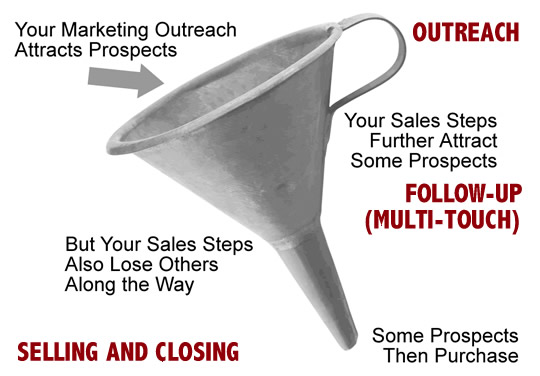
The sales funnel demonstrates the three parts.
OUTREACH — At the top is the entire universe of possible customers, and your outreach goes out toward them. Hopefully you have found a way to send it to people likely to want what you have, instead of just to the entire world. However, any outreach system will be imperfect, and for this reason, the outreach part is nearly always the most expensive of the parts, because it generally takes more money, time, and resources to reach the larger number of people.
FOLLOW-UP — Once the interested people you’ve reached have indicated their interest by responding to your outreach method, you capture their information so that you can initiate a follow-up conversation. And this follow-up conversation consists of several different messages over time, so that they are “touched” multiple times, and hopefully using multiple channels because in this way your follow-up messages are both more persuasive and are better received as you become known, liked and trusted.
SELLING AND CLOSING — Finally at some point, the most interested of these prospects enter into a conversation that results in their providing you money, and you get the information needed so that you can provide your products or services.
NOW WE CAN ADDRESS A MOST IMPORTANT QUESTION … WHICH OF THE 3 PARTS USUALLY FAILS THE MOST?
Let’s take the three activities required in a Marketing division of your company, but in reverse order —
3) Selling and closing
2) A reliable and ongoing follow-up system
1) An effective Outreach system
SELLING & CLOSING — Most business owners are competent or highly-skillful at selling their services.
FOLLOW-UP (MULTI-TOUCH) — As regards follow-up, some business owners have decent systems to do it, and some don’t.
OUTREACH — However, pretty much ALL struggling businesses have inadequate outreach, and that’s why they struggle, because they’re not getting enough prospects to talk to, so even with vigorous follow-up, there are just not enough closed sales, and so cash is always restricted, and the business is not really growing.
SUMMARY — Struggling businesses have weak Marketing systems, and of the three activities of a Marketing division, the one that is nearly always missing or erratic or completely ineffective is … the OUTREACH SYSTEM.
When you solve this one thing, you will solve about 80% of all the problems in your business, because solving this produces sales, which gives you cash, and there are very few business problems that cash won’t help.
And also for this reason, later in this special report, I’m going to show you an example of an effective outreach system.
If You Measure, You Can Manage. If You Can Manage, You Can Improve.
Let me tell you a little story.
I had been working with a small gym for a couple of months. The first month, I sent a huge number of new people to the gym, and then owner jumped on the phone calls, and communicated energetically via text, and kept very precise records of how many people, how many times followed-up, how many spoken with, how many appointments to come in, how many showed up, and how many bought, and how much cash was made in the very first month.
In a phone conversation we looked at these numbers, and it was clear that they’d made money above our costs in that very first month, and these new students would be paying the same amount next month (and for a year or more to follow), and so that was more than covering the cost of our lead-generation program, so the owner wasn’t actually going to ever pay for us again, because that first batch of new students would cover it, essentially forever, as we continued to send in new batches of students in every succeeding month, with the effect that the studio’s cash would rise and rise month by month.
The future was bright.
And then the next month, I again sent in new people, even more than the month before. They were no different from the previous month, and so I was so happy because I knew my client the studio-owner would be making even more money this second month.
But when I called up toward the end of this second month to get the numbers, I discovered that the owner had not kept any numbers, had not followed up energetically, had taken off for a vacation, and had brought very few of these people into the studio. The owner then said, “We did have some sales, but they were from people who came from word-of-mouth, and I think that in this particular month the people who came in were just trying out different places, and they were just going around to different studios.”
I tried to get some actual numbers, but the owner wouldn’t give me any numbers. The owners then sent me a text message next day saying that they couldn’t afford to continue. (Notwithstanding that we’d just sent them new folks to cover our cost basically forever, while we grew their client base.)
Now, what do YOU think happened?
I know what I think happened. For some psychological reason, after a wonderful initial success, the owner chose (consciously or unconsciously) to behave in a completely different way, neglecting the new prospects, abandoning the game, and then making up a wild and completely imaginary story about the nature of the prospects this month being completely different than the previous month to explain the “no sales,” although in fact there were sales, except somehow the owner now imagined that they didn’t come from the prospects but from some other place which had never happened before.
Do you get how crazy that is?
And it’s completely human.
So how can a business owner guard against this?
The answer is —
What you can measure, you can manage.
If you abandon measurement, you have no real information, so effective managing becomes guesswork.
If the business owner had simply kept the numbers, then it would be clear exactly how and where it broke down. Then, if the owner wanted growth, the answer is simple. Just fix the place where it’s most broken, and work the numbers. And grow.
By abandoning the measurement, the owner abandoned managing their growth. Then had no explanation except what they could make up out of thin air, and that a group of 70+ people had all somehow chosen strange erratic behavior which had never been seen previously.
OK, so how to measure? There are two ways. I’m going to be brief about this, and if you want more information about either of these two methods, feel free to contact our office and perhaps we can help. And again, if enough people want more information about this, perhaps we will write an expanded operations guide to spell it out more completely.
METHOD A: MEASURE EACH STEP IN THE CHAIN FROM A TO Z
Now what I mean is easiest explained by a marketing example of a company I ran in San Francisco. I ran a company called Network Answering Service, on Geary Boulevard, and we served clients all over town. At that time there was no such thing as the internet, and we had advertisements in the weekly Bay Guardian newspaper, in the Yellow Pages, and we had a postering company who put up posters with take-one cards on bulletin boards all around the city.
People seeing these ads would call, and our telephone operators answered, and then patched the call through to our sales rep(s), who answered, and then started a sign-up form, following a written script we’d tested and refined. At the end of the sign-up form, over 90% of the callers said yes and gave us a credit-card, and we set them up to receive our service.
Now that was the chain of events that led from an advertisement to a completed sale. When you think about it, the process could break down anywhere along the line. So if we had lower sales one week, how would we know what part had performed poorly?
The answer was to measure along the way. then if the final result was poor for the week, we look for the place along the chain which had not been successful. For example, at the end of the week, from records kept by the operators and records kept on the sales forms, we would know —
- how many times the sales line rang
- how many times the operator answered and got callers name and number written down
- how many times the patched call was answered by the sales rep
- how many sales forms were started (meaning our sales script was begun)
- how many sales forms were completed (meaning the complete script was delivered)
- how many paid-for sales did we have
Then of course on a bad week, you look at the numbers and discover that the sales rep was only picking up the patched call about half the time. Well of COURSE the final sales would be low, if the sales rep is only talking to half the people our paid advertising brought us.
Or, on certain weeks we’d see that the number of calls which arrived on the sales line was down. We soon learned of seasonal variations. For example, the week containing a major holiday would usually see a 30% reduction of inbound sales calls.
The measurement made management easy. The obvious thing to fix just leaped out. But we would never have known where it had broken without measurement along the chain from A to Z.
Your business will function similarly. If you measure at each step, you will know what to do. Then simply fix the most broken steps and your process will transform from weak and faltering and mysterious … in to predicatable and reliable and strong.
And the result? More sales completed. More growth.
Here is an illustration of the “chain” and the process …
METHOD B: GRAPH YOUR ‘KEY NUMBERS’
The examples given above were Key Numbers we kept for the Sales chain.
For every job in your company, and for every process, and for every person, there likely is some key number that reflects in a concrete way how well that job or process or person is performing to advance your profits and your goals.
For my job as the owner of that company, my key number turn out to be — after measuring a bunch of different numbers to see which ones correlated best with “we’re doing great!” and “we’re doing lousy!” — finally it became clear that a simple graph of how many clients we had gave the best indication of doing better or worse. (We could graph gross revenue, and that worked pretty well, but the client count was an earlier signal, so I used that.)
So after you guess and experiment you find one or two key numbers that tell you clearly how it’s going.
Now, the problem is this — A stack of numbers, like the cells in a spreadsheet, they go up, they go down, and sometimes it’s hard to see clearly whether they are overall improving or degrading right now.
But there’s a simple answer to that.
Graph the key numbers on a sheet of paper. You could do it on a computer to make it pretty, but the sheet of paper taped to the wall is quicker and easier.
Because of the way that human brains work, you can *SEE* the changes quicker and more clearly on a graph than you can with jiggling columns of figures.
Now, if your data is jumping up and down and it’s hard to see, that means that you are measuring too small a period of time. For example, with many key numbers, daily graphing would just show a spiky line all over the place. And if your weekly figures are too jumpy, you may have to change to a monthly time period. And that will provide a smoother graph.
But focusing on the most important numbers, and graphing them, you will KNOW how it’s going better than any other method.
Here’s a quick summary of how it works —
An Example of an Effective Outreach Program: Facebook Messenger System
A properly-designed and managed Facebook advertising program can be very effective as outreach to find new prospects to fuel growth of your business, no matter whether it is a yoga studio, real-estate brokerage, restaurant, hair salon, martial arts school, or a chamber of commerce.
And one variation of the Facebook advertising platform is to place ads on Facebook, and then send respondents into Facebook’s Messenger system. Notice that it provides both very targeted OUTREACH (which means best return on the cost), and it also provides automatic capture of prospect’s information to allow further conversation, and then it delivers FOLLOW-UP sequences (“Multi-Touch”) so that your proposition becomes more persuasive, and you become known, liked, and trusted.
Here’s why, in skillful hands, it works so well —
- Facebook has agreements with five large data providers, and so in addition to the information that users give Facebook when establishing their account, Facebook draws on the data vendors to create very detailed user profiles, including income, age and marital status, credit scores and spending habits, online interests, memberships in professional associations, home ownership, and lots, lots more
- This wealth of data allows the skillful targeting of advertisements so as to select the people most likely to be interested in your business. For example for the owner of a yoga studio we’d want to target people interested in yoga, exercise, healthy living, and who live near to the place of business.
- Assuming good copywriting and an attractive offer, these desirable prospects comment or click, and if it is set up properly, they can be taken automatically into the Messenger platform, where their facebook contact information can be captured, so that we can communicate with these same people again and again over time. (Follow-up, Multiple Touches)
- The Messenger platform, along with special software, allows us to send automated messages and elicit responses from the prospects, narrowing down their interest and delivering to them content they can find attractive. (Just as you are probably finding this special report’s information helpful to better see ways to grow your business; and unless a friend passed our report to you, we probably delivered this report to you via the Messenger platform.)
- From the Facebook user’s point of view, he/she didn’t have to stop and enlist and enter email or other information, because Facebook already has that, and with the correct programming we can build our list without troubling the user at all.
- The messenger platform can provide audio recordings, dial the user’s cellphone to connect them to your phone, play videos, deliver PDF reports with clickable links inside, take them to websites and class-schedule pages, and more. (Persuasive and helpful information delivered via Multiple Channels)
- And all of this on a platform that follows the user from computer to tablet to cellphone all automatically
- We can set up time-sequences to reach out to them much like drip-email
- We can create an on-going two-way conversation both now, and over time
- The business owner or employees can monitor and handle free-form follow-up conversations via Facebook’s live chat, which is already built-in
- Prospects can additionally be sent into Facebook Messenger sequences for customer support, content-delivery, and selling not just from Facebook, but also from your website, popup forms, blog posts, Facebook posts, LinkedIn and other social media posts, physical signs in your facility, and more.
- And finally users can be sent from this platform to your website, blog, social media, phone lines, or front-office staff.
There’s more, but you get the picture. This is a case where a combination outreach and follow-up program can be highly automated, working around the clock to bring you new business, and provide both outreach, follow-up communications, selling, and customer care functions.
There’s a lot of power here, and the laundry list of benefits here may not make it entirely clear in your mind how it works. For that you might need a bit of conversation about your situation and growth goals, and perhaps some private demonstration of how it works.
And so if you’d like to know more about how Messenger Marketing could produce an Explosion of new clients for your business, you are welcome to contact us, and we can see whether this might be a good fit for you.
Summary of this Special Report
We have now covered what are actually the simple methods by which a business owner can grow the business.
You now know —
- The one common problem of struggling businesses
- The one place where Marketing is always weak or broken in struggling businesses, and how to fix it
- How to measure so that you can finally manage your marketing and your business, with clear vision; and
- An example of what is surely the hottest and most powerful marketing method available today
And now the next step is yours.
If your business has been struggling, and now you know exactly how to achieve growth and profits, without the frustration and struggle and worry … what will you do next?
Will you move forward to improve your business, and your life?
Or will you somehow let it slide, and then as memory grows dim, and as things that are merely urgent crowd out what’s really important to give you the life you live, will you forget and just go on, raging against the endless struggle, feeling like a failure, angry at those around you?
Personally, I hope not.
I invite you to reach out, to again reach for your dreams.
I suspect we can help.
Want to find out? See how it works? Take a look at how your business might transform into steady growth, with new people showing up every week, calling your phone, walking in your door?
If you like the sound of that, here is your next step …
Resources — Are You a Good Candidate? Get a Fast Business-Growth Analysis, for Free.
A) Would you also like to see our profitable video “The Magic Formula to Unlock Profits and Growth with Smart Advertising?” This information-packed video spells out the exact steps so that you can quickly determine —
1. What is a customer worth?
2.What is an advertisement worth?
3.What is the Return on Investment?
4.How to know which ads to keep
5.How to use a simple Advert ROI calculator (provided free)
To watch this video, visit http://voltos.us/ADVERTGROWTH
B) Are you a good candidate to work with us?
To find out, please provide brief background information about yourself and your company goals: http://voltos.us/DISCOVERY
B) Do you wish to book time for a private discussion, to see whether this might be a fit for your operation?
Note: We can only work with principals in a business, the person who makes decisions for the business and has budgetary authority. If this is you, then please request a time for a private meeting.
Request a private meeting here: http://voltos.us/SCHEDULE
Thank you! We hope this information has proven useful for you, and we wish you the best in growing your Business reliably, the smart way!

Additional Resources
- Download a PDF of this special report —
“How to Grow Your Business Rapidly, without Going Crazy or Bankrupt!”
…. http://voltos.us/HOWTOGROWPDF - View quick-start video —
“The Magic Formula to Unlock Profits and Growth with Smart Advertising”
…. http://voltos.us/ADVERTGROWTH - View super-short demo video of today’s most POWERFUL outreach marketing method —
(This short example demo is for a yoga studio, but works in all niches, and for many marketing and customer-care purposes, including a) attracting new business; b) providing your special offers; c) distributing lead-magnets or sales materials; d) providing interactive FAQ to prospects; e) tours, quizzes, surveys and more)
…. http://voltos.us/YOGADEMO - Want to See a Complete System? If you’d like to see a working system in complete detail — and get all your questions answered — we can do that. Because we have a Demo which reveals a complete “Walk New People in the Door” system, showing all steps in order. Request your private demo here —
…. http://voltos.us/SCHEDULE

